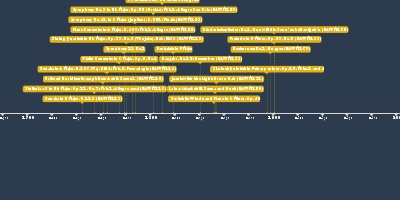1 jan 1827 ano - Winterreise, D. 911: No. 5, Der Lindenbaum (NAWM 129)
Descrição:
Composer: SchubertGenre: song cycle (composer sets a series of poems, usually by a single poet, that together tell or suggest a story)
Translation: Winter's Journey; The Linden Tree
Consists of a cycle of 24 poems by Wilhelm Muller. The entire cycle relates the inner experiences of a young man who, in the cold of winter, revisits places he remembers from the previous spring and summer, when he met and wooed a young woman who later spurned him. When Schubert wrote this, he was growing increasingly sick with syphilis, and thus his own gloom and despair may have bled into this piece.
No. 5, The Linden Tree:
Contrasts the pleasant memories of this linden tree with its current reality. In warmer times he lay dreaming beneath the tree and carved loving words into its bark, but now its leafless boughs rustle in an icy wind, calling him back to a rest that can only mean death.
Form
The poem is strophic, while the song is a modified strophic form (AA’BA”).
A
This folk-like E major melody sets first two stanzas of the poem, which describe past joys. It's accompanied by chordal harmony in the horn-call style.
A’
Repeats A melody for the next two stanzas but uses a broken chord accompaniment. Shifting to the parallel key of E minor, the young man speaks of walking by the tree in the dark, returning to E major as the rustling boughs that call him back.
B
In this fifth stanza, he describes a cold wind that seems to push him back to the tree. It's set in dramatic declamatory style of a variant of the fluttering triplet figuration.
A”
This final stanza is sung twice to the melody of A , back E major and over an accompaniment similar to A’. The young man is far from the linden tree, bet he still hears it calling. The combination of features from previous sections well represents this emotional conflict.
Musical ideas
Brief prelude in the piano introduces a fluttering triplet figuration, representing gentle breezes and whispering leaves of summer. The same figuration returns later but is altered with chromatic harmonies, then representing the cold wind and eerie rustling of the tree in winter. It also acts as an interlude and postlude, so serves a a frame for the verses in between.
A horn call closes the prelude and returns before the last stanza, suggesting nature and the outdoors, but also distance (since hunting horns were often heard from afar) and thus separation from the beloved.
The vocal melody is simple and folk-like, qualities well suited to express the simple pleasures that brought the young man happiness and now are only distant memories.
Adicionado na linha do tempo:
Data:
1 jan 1827 ano
Agora
~ 198 years ago
